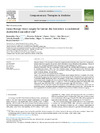Please use this identifier to cite or link to this item:
https://accedacris.ulpgc.es/handle/10553/107271
| DC Field | Value | Language |
|---|---|---|
| dc.contributor.author | Clavo, Bernardino | en_US |
| dc.contributor.author | Robaina, Francisco | en_US |
| dc.contributor.author | Urrutia, Gerard | en_US |
| dc.contributor.author | Bisshopp, Sara | en_US |
| dc.contributor.author | Ramallo, Yolanda | en_US |
| dc.contributor.author | Szolna, Adam | en_US |
| dc.contributor.author | Caramés, Miguel A. | en_US |
| dc.contributor.author | Fiuza, María D. | en_US |
| dc.contributor.author | Linertová, Renata | en_US |
| dc.date.accessioned | 2021-05-24T14:11:12Z | - |
| dc.date.available | 2021-05-24T14:11:12Z | - |
| dc.date.issued | 2021 | en_US |
| dc.identifier.issn | 0965-2299 | en_US |
| dc.identifier.other | Scopus | - |
| dc.identifier.uri | https://accedacris.ulpgc.es/handle/10553/107271 | - |
| dc.description.abstract | Objectives: Surgery is the treatment of choice for symptomatic disc herniation after conservative management. Several studies have suggested the potential utility of intradiscal ozone infiltration in this pathology. The aim of this trial was to compare intradiscal ozone infiltration vs. oxygen infiltration vs. surgery. Design and interventions: This was a randomized, double-blinded, and controlled trial in patients on a waiting list for herniated disc surgery. There were three treatment groups: surgery; intradiscal ozone infiltration (plus foraminal infiltration of ozone, steroids, and anesthetic); intradiscal oxygen infiltration (plus foraminal infiltration of oxygen, steroids, and anesthetic). Main outcome measures: The requirements for surgery. Results: Five years after the treatment of the last recruited patient (median follow-up: 78 months), the requirement for further surgery was 20 % for patients in the ozone group and 60 % for patients in the oxygen group. 11 % of patients initially treated with surgery also required a second surgery. Compared to the surgery group, the ozone group showed: 1) significantly lower number of inpatient days: median 3 days (interquartile range: 3–3.5 days) vs. 0 days (interquartile range: 0–1.5 days), p = 0.012; 2) significantly lower costs: median EUR 3702 (interquartile range: EUR 3283–7630) vs. EUR 364 (interquartile range: EUR 364–2536), p = 0.029. Conclusions: Our truncated trial showed that intradiscal ozone infiltrations decreased the requirements for conventional surgery, resulting in decreased hospitalization durations and associated costs. These findings and their magnitude are of interest to patients and health services providers. Further validation is ongoing. | en_US |
| dc.language | eng | en_US |
| dc.relation.ispartof | Complementary Therapies in Medicine | en_US |
| dc.source | Complementary Therapies in Medicine [ISSN 0965-2299], v. 59, 102724, (Junio 2021) | en_US |
| dc.subject | 32 Ciencias médicas | en_US |
| dc.subject | 3201 Ciencias clínicas | en_US |
| dc.subject.other | Cost-Effectiveness | en_US |
| dc.subject.other | Disc Herniation | en_US |
| dc.subject.other | Microdiscectomy | en_US |
| dc.subject.other | Ozone Therapy | en_US |
| dc.subject.other | Randomized Controlled Trial | en_US |
| dc.title | Ozone therapy versus surgery for lumbar disc herniation: A randomized double-blind controlled trial | en_US |
| dc.type | info:eu-repo/semantics/Article | en_US |
| dc.type | Article | en_US |
| dc.identifier.doi | 10.1016/j.ctim.2021.102724 | en_US |
| dc.identifier.scopus | 85105507347 | - |
| dc.contributor.authorscopusid | 57190093030 | - |
| dc.contributor.authorscopusid | 6603449723 | - |
| dc.contributor.authorscopusid | 7003560077 | - |
| dc.contributor.authorscopusid | 57200531623 | - |
| dc.contributor.authorscopusid | 35604397600 | - |
| dc.contributor.authorscopusid | 14032568700 | - |
| dc.contributor.authorscopusid | 6505906726 | - |
| dc.contributor.authorscopusid | 56698082300 | - |
| dc.contributor.authorscopusid | 26021346200 | - |
| dc.identifier.eissn | 1873-6963 | - |
| dc.relation.volume | 59 | en_US |
| dc.investigacion | Ciencias de la Salud | en_US |
| dc.type2 | Artículo | en_US |
| dc.description.numberofpages | 5 | en_US |
| dc.utils.revision | Sí | en_US |
| dc.date.coverdate | Junio 2021 | en_US |
| dc.identifier.ulpgc | Sí | en_US |
| dc.contributor.buulpgc | BU-MED | en_US |
| dc.description.sjr | 0,624 | |
| dc.description.jcr | 3,335 | |
| dc.description.sjrq | Q1 | |
| dc.description.jcrq | Q2 | |
| dc.description.scie | SCIE | |
| dc.description.miaricds | 10,9 | |
| item.fulltext | Con texto completo | - |
| item.grantfulltext | open | - |
| crisitem.author.dept | GIR IUIBS: Farmacología Molecular y Traslacional | - |
| crisitem.author.dept | IU de Investigaciones Biomédicas y Sanitarias | - |
| crisitem.author.dept | GIR SIANI: Ingeniería biomédica aplicada a estimulación neural y sensorial | - |
| crisitem.author.dept | IU Sistemas Inteligentes y Aplicaciones Numéricas | - |
| crisitem.author.dept | GIR IUIBS: Farmacología Molecular y Traslacional | - |
| crisitem.author.dept | IU de Investigaciones Biomédicas y Sanitarias | - |
| crisitem.author.orcid | 0000-0003-2522-1064 | - |
| crisitem.author.parentorg | IU de Investigaciones Biomédicas y Sanitarias | - |
| crisitem.author.parentorg | IU Sistemas Inteligentes y Aplicaciones Numéricas | - |
| crisitem.author.parentorg | IU de Investigaciones Biomédicas y Sanitarias | - |
| crisitem.author.fullName | Clavo Varas, Bernardino | - |
| crisitem.author.fullName | Robaina Padrón, Francisco | - |
| crisitem.author.fullName | Bisshopp Alfonso, Sara | - |
| crisitem.author.fullName | Ramallo Fariña, Yolanda | - |
| crisitem.author.fullName | Zbigniew Szolna,Adam | - |
| crisitem.author.fullName | Caramés Álvarez,Miguel Angel | - |
| crisitem.author.fullName | Fiuza Pérez,Mª Dolores | - |
| Appears in Collections: | Artículos | |
SCOPUSTM
Citations
10
checked on Jun 8, 2025
WEB OF SCIENCETM
Citations
9
checked on Jun 8, 2025
Page view(s)
137
checked on Dec 14, 2024
Download(s)
447
checked on Dec 14, 2024
Google ScholarTM
Check
Altmetric
Share
Export metadata
Items in accedaCRIS are protected by copyright, with all rights reserved, unless otherwise indicated.
